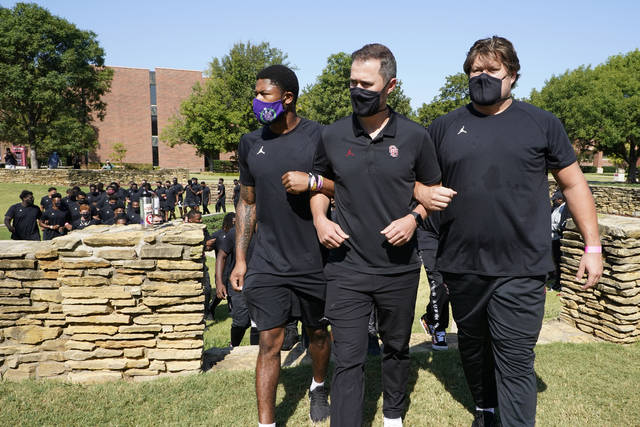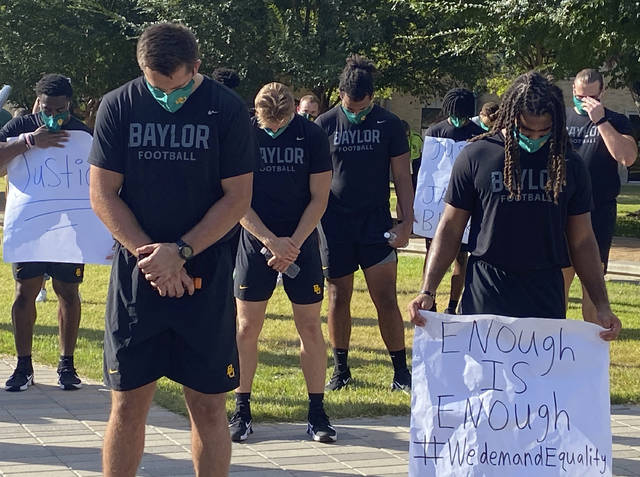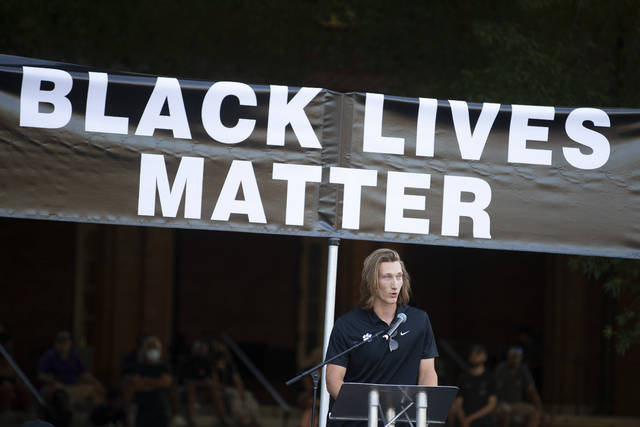


College athletes come and go, cycling through their programs and campuses in about four years. Organization has been difficult to attain. Motivating people to band together and fight for reforms when they might not be around to reap the benefits is challenging.
This summer there have been signs that is changing.
College athletes have called out coaches and administrators, backed causes both social (Black Lives Matter) and political (changing the Mississippi state flag) and demanded to be part of the discussion about whether sports can be played safely during a pandemic. They have organized campus marches, threatened boycotts and trended on social media without stepping foot on a field.
If this moment spawns a sustained movement, it will be because college athletes have learned to harness their collective power and laid a foundation for their successors.
“We all know that this isn’t a movement for the present,” said Jaydon Grant, an Oregon State defensive back and a leader of the Pac-12 We Are United group. “As far as establishing something that lasts, I know that we’ll all be gone in a few years, all removed from college football, but I don’t look at it any differently than how you build the culture of a program.
“With good leadership and good morals you build successful programs in college football and college athletics,” he said. “And that’s kind of the same thing we’re trying to do.”
We Are United grabbed headlines last month with a bold and broad list of demands and a threat of mass opt outs of practices and games if the Pac-12 did not address them. The coronavirus and athlete compensation issues got most of the attention, but concerns about racial injustice in college sports truly spurred their movement.
Within days, Big Ten United emerged — a group spun out of College Athlete Unity, founded earlier this year by athletes to “address systemic injustices in our communities.”
Within a week, those two groups connected with players in other conferences, most notably Clemson star Trevor Lawrence to create the social media campaign #WeWantToPlay, which called for, among other things, the formation of a college football players association.
“The scale of the discussions was never what it is right now,” said Michigan defensive back Hunter Reynolds, a College Athlete Unity founder. “It’s athletes from all across the country, all sports in all divisions kind of talking among themselves now. I think that’s probably the biggest takeaway: Starting the connections, like, the nationwide connections.”
The specific goals of each group are not perfectly aligned. As some conferences postponed their fall seasons, players pushed to play and some are still doing so.
Still, the players say they don’t need unanimity to work together. They have been encouraged to see their efforts attract a wide range of athletes from future NFL millionaires such as Lawrence and Oregon offensive lineman Penei Sewell to walk-ons and athletes outside of football.
“We all look at each other as equals,” Grant said. “We all realize that no man or woman is more important than the other. No sport is more important than the other.”
Longtime observers of college sports and the NCAA marvel over what athletes have accomplished this year.
Tim Nevius, an attorney and former NCAA investigator, said too often the debate over whether college athletes should be paid overshadows other issues. That the NCAA made its COVID-19 guidelines to members schools mandatory after athletes pushed for more stringent requirements was a huge win for players’ rights, he said.
“I think that the message that the players are sending has staying power,” Nevius said. “They’re advocating for basic rights and fundamental fairness.”
College sports leaders often tout the NCAA’s Student-Athlete Advisory Committees as a shining example of how athletes are given the opportunity to influence policies. SAAC representative sit on all sorts of committees. They have input in the legislative process and voting rights.
Gabe Feldman, director of Tulane’s sports law program, said SAAC provides athletes a voice, but little power.
“I think SAAC is a good group. And I think it’s important and I think it should continue, but it does not serve the same purpose as a unified structure that can actually have a true seat that the table,” Feldman said.
Reynolds, the Michigan player, compared SAAC to student-body government in high school.
“They’re fine having the students vote on the brand of chocolate milk that’s going to be in the cafeteria but when it comes to budget cuts and things of that nature that’s when the student becomes pretty ignored,” Reynolds said.
Reynolds said the ultimate goal is that so-called seat at the table, but some who support the athletes question whether they can get there without help from lawmakers. Earlier this month a group of senators led by Democrats Cory Booker (N.J.) and Richard Blumenthal (Conn.) announced a c ollege athlete bill of rights they hope will be the foundation of sweeping legislation.
Donna Lopiano, a former college sports administrator and coach who now runs a sports management consulting firm, said college athletes’ greatest power lies in their willingness to not play.
“The athletes have to realize that they can get what they need if they’re willing to do that,” Lopiano said. “Look at what the institutions are doing now just to play. If the athletes say, ‘You know, forget about that money.’ I’m not sure they know the power they have.”
A move to unionize football players at Northwestern was blunted by a National Labor Relations Board ruling in 2015. But Feldman said the players could get the representation they desire without a labor union.
“Just look at almost every professional association: Doctors, lawyers, dentists, plumbers, who aren’t in a union, but come together to benefit their profession,” he said.
Jay Bilas, a former Duke basketball player and frequent NCAA critic who now does work for ESPN, said college athletes are more aware of their power than ever before. He called this summer an inflection point for college athlete rights.
“Any decision about them should not be made without them,” Bilas said. “And right now, all decisions made about them are completely without them.”
But for how much longer?
‘“Just because something is either going to take a long time or is going to be difficult doesn’t mean it’s not something that should be addressed,” Reynolds said. “So we felt like if we start addressing these things now … getting the ball rolling on addressing some of the issues that we felt strongly about that we could really create change that we might not see, but maybe 10 years down the road college athletes don’t have to worry about the same things we worry about.”
___
Follow Ralph D. Russo at https://twitter.com/ralphDrussoAP and listen at http://www.westwoodonepodcasts.com/pods/ap-top-25-college-football-podcast/
___
More AP college football: https://apnews.com/Collegefootball and https://twitter.com/AP_Top25




